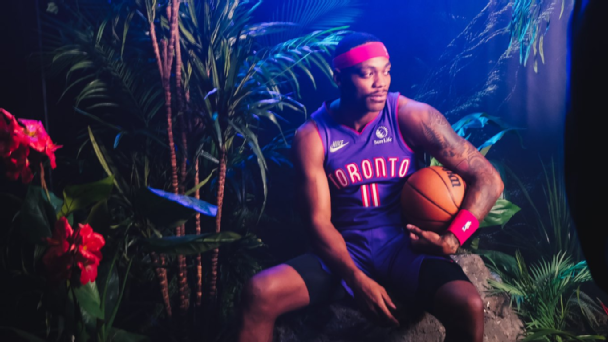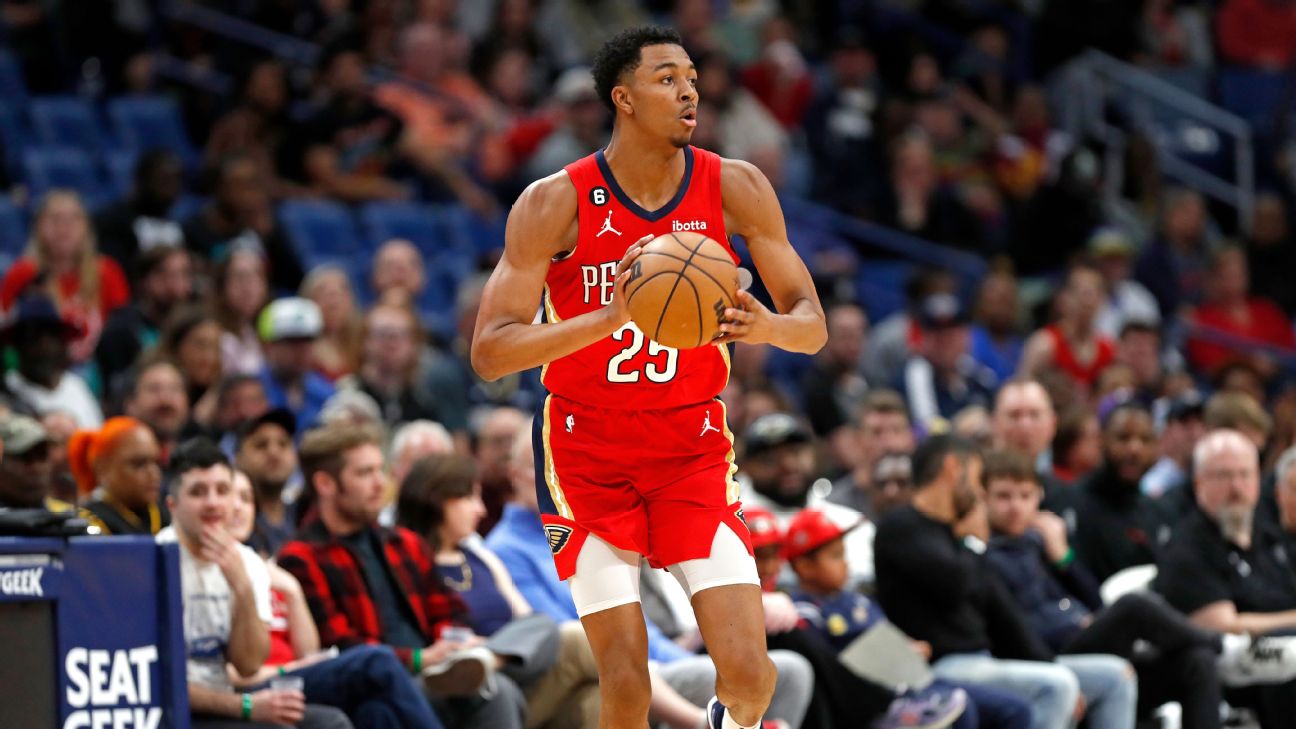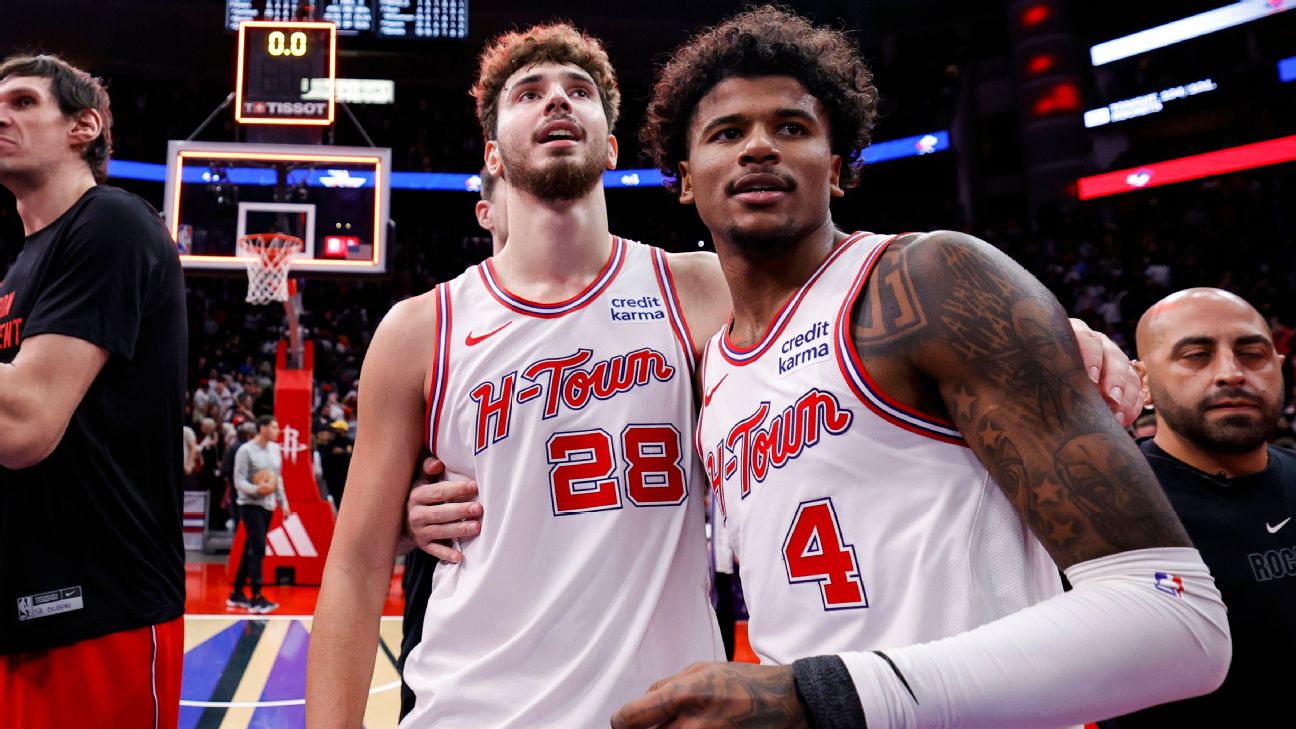In this week’s nine things I liked and disliked, the James Harden trade has opened the LA Clippers’ championship window (again), Luka Doncic playing … defense(!) and why the Sacramento Kings aren’t interested in trading second-year forward Keegan Murray.
| Keegan has arrived
Coby’s breakthrough | Sengun’s All-Star case
Hartenstein’s revelation | Charlotte’s non-rotations
Blazers doing too much on TV?Luka playing D! | NBA players are just like us

1. The LA Clippers’ defense, and are you ready to love again?
When the Clippers made their last big all-in move for James Harden, the most skeptical analysts questioned if the trade put them on level with the Denver Nuggets. That was the wrong framing. If you’re judging every trade that way, there won’t be many trades.
The Harden deal unquestionably made the Clippers better. They went from “no chance” to “some chance.” The right standard was whether the Clippers could gel into a team that made you believe — a team with fight and cohesion, one in which the stars sacrificed and lifted each other up. That team could still lose — maybe even in the first round. The health risks with Kawhi Leonard and Paul George will always be there. Harden has petered out in too many mega games.
But a team with that spirit can be worth it even in defeat. Two months after bottoming out at 3-7 in a humiliating loss to the Nuggets’ backups — including some ghosts of Clippers past — the Clippers look like that kind of team. They are 21-6 since, with the league’s No. 4 scoring margin.
The eye test is even more convincing. You know a serious team when you see it, and this is a serious team. As with most superstar conglomerates, it has been natural to focus on the offense: How would the Clippers split up touches? Would the stars diminish each other? Would Russell Westbrook accept a bench role (again)? Would all these players accustomed to dribbling and jab-stepping actually take catch-and-shoot 3s?
The Clippers have answered a lot of those questions. But their work on defense might be more telling. They are up to 11th in points allowed per possession. That’s not incredible, no. These are not the Kevin Garnett Boston Celtics. There are off nights.
But when the Clippers dial in, they can reach a very high level. Leonard and George remain maybe the league’s premiere wing defense tag team. Leonard is defending as well as he has at any time as a Clipper, and taking on the toughest assignments — including Stephen Curry, Zion Williamson and Kevin Durant in recent games.
Opponents are shooting just 49% at the rim against Ivica Zubac, one of the stingiest marks among bigs. Terance Mann is fast and reliable. Harden is so strong and smart that he can at least approach neutral impact if he tries — if he doesn’t fall into a basketball coma on five possessions every night. The Clippers play zero small guards — no easy size mismatches for scorers to hunt.
Game by game, they add layers. Coach Tyronn Lue will toggle matchups in ways the opponent might not expect. If the opponent has one or two non-shooters on the floor, the Clippers may have Zubac suddenly blitz pick-and-rolls — forcing the offense to pass the ball until it ends up where the Clippers want it. If that one non-shooter is in the strongside corner, the Clippers may help away from that player anyway, breaking the normal rules of NBA defense. They have even dabbled with zone.
There are glimmers of improvisation too. Two players switch in a wink, without any blips of hesitation. One defender decides to fly at an opposing shooter; everyone else reads that and covers space in kind. When these guys shift around and zone up with their arms spread, they can blot out lots of passing lanes — or at least make you think twice.
Lue is stretching them, and the players are proving up to it. They allow an average number of 3s and very few shots at the rim. They aren’t bad at anything. They don’t beat themselves.
Leonard’s surprise move this week to ink a three-year, $153 million extensionto trade everything — including Shai Gilgeous-Alexander — to pair Leonard and George. If George follows suit, the Clippers can approach the postseason without any uncertainty.
The Clippers have won three playoff series in four Leonard-George seasons. In cold results, that is a failure. But the Clippers are more relevant now. Two stars chose them — and have chosen to stay. They made the conference finals for the first time. That was in 2021, and they have won one playoff game since. That run — which ended with Leonard injured and a six-game loss to the Phoenix Suns — came to feel like it might have been their last, best chance.
and then Philadelphia going haywire. Would the Clippers be viable contenders with Malcolm Brogdon or some other placeholder guard? Maybe not.
But they got Harden, and their window is open again.
2. Keegan Murray is here
When you taste success after 15 years in the dumpster, it must be tempting to rush toward more.
The Kings are 23-14, on pace for 51 wins. That likely won’t earn the No. 3 seed again. Slip to 49 or 48 and they may land in the play-in.
Their point differential tells a more fretful story: The Kings are only plus-38 this season, 12th on offense and 16th on defense — close to average. They have suffered several ugly blowout losses. What is the more accurate reflection of team quality — its record or its point differential?
The Kings feel ripe for a megadeal. De’Aaron Fox and Domantas Sabonis are 26 and 27, respectively — in their primes, ready to win. They own all their future picks save one first-rounder and one second-rounder. Two of their starters — Kevin Huerter and Harrison Barnes — aren’t bringing enough punch. Combined, they make $33 million — enough to get the Kings into any trade conversation.
They have held at least internal discussions about almost every available big name, including Zach LaVine, Pascal Siakam and OG Anunoby, sources said. Anunoby looked like perhaps the cleanest fit, but the Kings do not appear to have gotten far there; they had no expendable young player the Toronto Raptors coveted.
Murray would be that player, but the Kings have shown zero interest in discussing him, sources said. They are also concerned adding a third massive salary would hamper their roster flexibility beyond this season — especially if they trade away picks.
Given all those constraints, I wonder if the best move might be standing (mostly) pat and keeping their powder dry, even if it means a slight step backward this season. Part of that is the possibility of the third major cog already being in-house: Murray.
Over the past month, Murray is averaging 19.2 points on 53% shooting and 45% from 3. He’s doing more with the ball in handoffs and straight pick-and-rolls:
Murray is shooting 50% on midrangers and loves that step-back on 2s and sometimes 3s. He does a little of everything — a shape-shifter who calibrates his game based on what the moment requires.
— Murray slides up a position. He can play as a true wing in bigger lineups with both Trey Lyles and Sabonis. (The Fox/Monk/Murray/Lyles/Sabonis lineup has played only 10 minutes together; Brown used it to close Sacramento’s win over the Detroit Pistons on Tuesday, and it should become a more regular feature.)
3. Coby White’s in-between game
This should not be happening — White thriving as the Chicago Bulls’ lead ball handler, and often their best player. The Bulls are supposed to belong to DeMar DeRozan, Zach LaVine and Nikola Vucevic. Lonzo Ball was the point guard to tie that medium three together. The Bulls added other guards to take White’s minutes, or at least compete for them.
But as I wrote here almost exactly a year ago, you could see signs of this breakout coming. He was a sturdier player — cagier with the ball, more confident, fighting harder on defense. It didn’t show in his statistics last season because the Bulls only had so many touches for White.
LaVine’s foot injury opened the door to a larger role. White burst through it, and neither he nor the team appear to be looking back. In 25 games since Nov. 19, White is averaging 22.3 points — tied with DeRozan for the team lead — on 47% shooting and 44% on 3s. LaVine and Vucevic are healthy again, but the Bulls are keeping the ball in White’s hands. He’s earned it.
Crafty! White turns Nick Richards into a statue with that hesitation dribble and then dusts him with a crossover before flicking that baby off the glass.
White can hit the gas when he needs to:
He crosses left, blasts Terry Rozier off-balance and kisses in that ultra-tricky leaner.
The Bulls have scored 113.6 points per 100 possessions with White on the floor and just 102 when he sits — the latter five points below the Memphis Grizzlies’ 30th-ranked offense. Chicago is plus-6.2 points per 100 possessions when White plays without DeRozan, per Cleaning The Glass.
White is the biggest reason Chicago is 9-5 in its past 14 games, atop a four-team slap fight (against the Atlanta Hawks, Toronto Raptors and Nets) for the ninth and 10th seeds in the East. Bulls fans don’t want to hear this, but if Chicago maintains this level, it’s a good bet to make the play-in.
, finding the right level
The Houston Rockets hanging in at No. 5 in points allowed per possession is one of the season’s true surprises. They may be getting a little lucky; Houston’s opponents have hit a league-low 33% on 3s. The Rockets have played only 15 road games, tied for fewest overall.
But the Rockets play hard and are well-coached. They have survived recent absences of Dillon Brooks and Tari Eason — two very good multi-positional defenders.
Sengun has made huge strides in effort and technique, even as the Rockets have tested him by mixing up coverages. Sengun is savvy, tough and ultraphysical — with quick hands. He has improved contesting shots at the rim.
One thing to monitor: Sengun can get caught in no man’s land against the pick-and-roll — not high enough on the floor to dissuade ball handlers, but too far outside to protect the basket:
If that screen hits, Damian Lillard strolls into an open 3. Fred VanVleet gets around it, but Sengun gives Lillard too long a runway. (Sengun often opens his hips early, almost escorting ball handlers to the rim.)
Sengun realizes he has to meet Lillard higher up, but he’s late and has to scramble; when Lillard revs up, Sengun can’t reverse momentum in time to contain him.
in contention for home court in the first round despite Mitchell Robinson’s ankle injury. Hartenstein has been good enough that the Knicks don’t have to splurge on a stop-gap center; they can (and did) use resources elsewhere.
Even in those early career garbage time stints, Hartenstein’s passing leaped out. The problem was almost everything else. He fouled so often that he literally could not stay on the floor. He turned the ball over way too much for a low-usage big. His defense was scattershot.
He started to clean those things up during his brief stint in 2020-21 with the Cleveland Cavaliers. It was clear by then that Hartenstein was ready to be a full-time backup.
Slinging dimes around opposing reserves for 12 minutes is one thing. Holding it down on both ends for 35 minutes is entirely different. Hartenstein is shooting 60%, pinging snazzy passes, inhaling rebounds and snagging almost 3.5 steals and blocks combined per 36 minutes.
Hartenstein’s passing is helping to inject some verve into New York’s battering ram offense. Donte DiVincenzo is a leaping, lunging blur of cuts and offensive rebounds. Josh Hart is a human fast break. Jalen Brunson and Julius Randle have been shiftier away from the ball.
Hartenstein’s defense is the revelation. There’s nothing fancy about it. It’s just nailing a dozen little decisions — of angles and timing — possession after possession. It requires hyper-vigilance.
Hartenstein is staying under control, maintaining balance, covering tons of space — even sometimes manipulating opposing ball handlers:
Hartenstein cuts off Anthony Edwards while staying close to Rudy Gobert. (That is well-timed help from DiVincenzo behind him.) Hartenstein reaches toward Edwards; Edwards picks up his dribble in response and lobs to Gobert — wagering Hartenstein can’t retreat in time. Wrong.
That’s a jailbreak for Kyle Kuzma. One little jab from Hartenstein undoes everything. Kuzma gets skittish, picks up his dribble and makes an addled choice between an awkward floater and that ill-fated lob.
are 3-18 in their past 21 games. They are 26th in offense and 29th in defense. Opponents have mauled them by 11.1 points per 100 possessions, a figure that would rank dead last most seasons. In this one, the Pistons are even worse. It’s a testament to Detroit’s historic awfulness that Charlotte could lose this much — including 11 straight recently — yet receive almost zero national scrutiny. Congratulations to everyone involved.
Injuries have spared Charlotte some wrath. LaMelo Ball hasn’t played since late November and is questionable for Friday’s game. Gordon Hayward, Cody Martin, and Mark Williams have missed a ton of games. Frank Ntilikina has not played. Even P.J. Washington is dinged up.
The defense has taken the worst hit. The Hornets do basically nothing well, and are out of sorts in all the ways you’d expect from such an inexperienced group. They miss rotations, botch switches and get lost in transition.
Their weakside rotations are a mess; the veterans are not blameless.
Miles Bridges starts that rotation a full second late; he’s leaning the wrong way — toward Andre Drummond — when White’s pass is halfway to Patrick Williams. Bridges has no chance to recover.
This is Bridges’s rotation too:
This time it’s Nick Smith Jr. — the low man on the weakside — who never arrives to help:
Only two teams yield more shots at the rim than the Hornets. Every game is a parade of marauding dunks. Charlotte allows an average number of 3s, but its opponents are shooting 40% from deep — highest in the league. Some of that is luck, but a good amount is on the Hornets.
, test the market for everyone else and prepare for a transitional summer with another lottery pick and new ownership putting its stamp on the organization.
7. Do we like these innovations from the Portland Trail Blazers broadcast?
The Blazers broadcast is close to unassailable. Kevin Calabro is a legend on play-by-play. Lamar Hurd is a rising star. The Blazers have the league’s best art.
Tom Haberstroh pops in with statistical nuggets — one of many fun quirks the Blazers have tried. Innovation is good, but at times I’ve wondered if they are going a little too far. Does this “possession tracker” do anything for you?
For me, it’s visual clutter.
This substitution tracker is less intrusive:
They also have a milestone alert to highlight statistical minutia:
other than they’ve done well to be 23-16 despite streams of injuries. Doncic and Kyrie Irving have appeared in only 20 games together. The current wounded list includes Dante Exum, Dereck Lively II, Maxi Kleber and Grant Williams. Doncic seems to be limping every game; he sat out Thursday night against New York.
Amid the training room churn, Dallas has crept to 18th in points allowed per possession. The schedule has contributed; its past 15 games have featured several punchless, injury-ravaged opponents.
But three of Dallas’s most important defenders — Lively, Exum and Williams — have all missed games. Williams has a lingering ankle issue; the Mavs need his 3-and-D skill set to reach their ceiling. (One benefit of Lively’s injury is the Mavs exploring small-ball lineups with Williams and Derrick Jones Jr. as the only big men. Kleber would add versatility if he can get healthy. Josh Green and Jaden Hardy have shown signs of life with additional minutes.)
If the Mavs hover at league average on defense, they will be a dangerous playoff team — a threat to win a round, for sure — provided they score at a top-5-ish rate. Their offense has slipped to No. 10. They will be better than that; the Mavs have poured in 120 points per 100 possessions with Doncic and Irving together — equivalent to Milwaukee’s No. 3-ranked offense — and reserve units will hum when coach Jason Kidd can keep one star on the floor.
The jury is out on their defense, but Doncic is giving more on that end than ever. There are still possessions and games where Doncic’s feet look heavy and he just kind of lurches around. The Mavs stash him on weaker offensive players.
But Doncic is engaged. His ability to read the game on offense translates to defense; he anticipates ball movement patterns. He’s switching onto all kinds of players, and sliding his feet:
Some leeway from the referees helps, but that’s Stephen Curry! Opponents have scored only 0.83 points per possession on isolations against Doncic — 49th among 320 guys who have defended at least 20 such plays, per Second Spectrum. He’s even stouter on the block; opponents have managed 0.533 points per possession directly out of post-ups against Doncic — second lowest among players who have guarded at least 20 such plays.
last week:
It happens. And, yes, whatever Adam Silver has to do to give us the Milwaukee Bucks against Indiana in the first round — do that.



